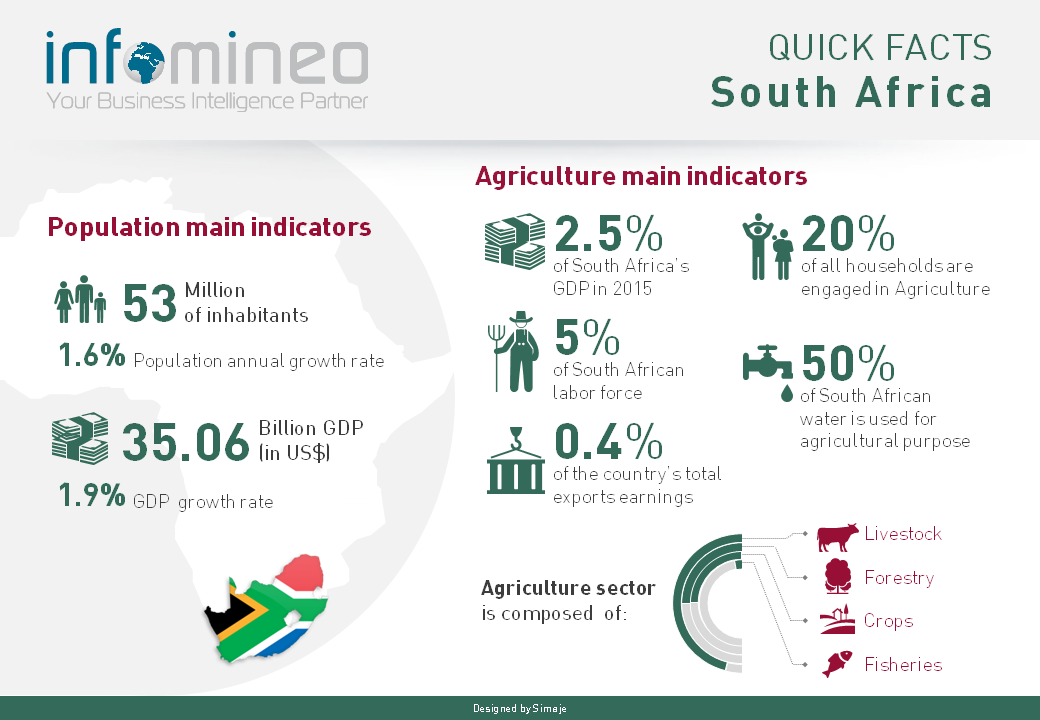Agriculture as a percentage of GDP has decreased over past five decades, currently contributing around 2%. This implies that the economy is maturing, moving towards the secondary and tertiary sectors.
However, farming remains vitally important to the economy with approximately 750 000 people formally employed in the sector – although it’s estimated that around 8,5-million people are directly or indirectly dependent on agriculture for their employment and income.
Agriculture Sector

South Africa classifies 79.4% of its land as agricultural, with the permanent pasture accounting for 69.2%— suitable for grazing and livestock farming. Types of Commodities in the Agri Economy
Cereals and Grains
Overall, Agriculture contributes 2. 4% to South Africa’s gross domestic product (GDP). The Grain industry is one of the largest subsectors in the South Africa, producing about 30% of the country’s total gross agricultural production. Maize, wheat and sunflower account for the largest area of farmland. Up to 15,000 farmers produce maize, most of whom are in the northwest, northern, and eastern Free State, the Mpumalanga Highveld and KwaZulu-Natal midlands. The country is the top maize producer in Africa and 12th in the world, behind some of the world’s largest producers such as the US, Argentina, Brazil, and Mexico among others.
Maize, the country's most important crop, is a dietary staple, a source of livestock feed, and an export crop. Government programs, including generous loans and extension services, have been crucial to the country's self-sufficiency in this enterprise.
Wheat is produced mainly in the Western Cape and the eastern parts of the Free State. Average wheat production has been constant over time against a steady increase in consumption, leading to remarkable rise in imports to meet local demand. Barley which is another important grain especially in the brewing industry is produced mostly on the southern coastal plains of the Western Cape. The region accounts for over 98% of the country’s barley production.
Vineyard (Fruits)
South Africa is a major producers and exporter of some of the highest quality of deciduous fruit and citrus. Western Cape and in the Langkloof Valley in the Eastern Cape are the main deciduous fruit growing areas. Important export groups are wine, citrus, grapes, apples, pears and quinces. The industry’s export earnings account for more than 10% of South Africa’s total agricultural export’s earnings.
Fresh fruit finds a good market in Europe because it matures during the northern hemisphere's winter. Deciduous fruits, including apples, pears, and peaches, are grown primarily in areas of the Western Cape and the Eastern Cape, where cold winters and dry summers provide ideal conditions for these crops.
Pineapples are grown, primarily in the Eastern Cape and KwaZulu-Natal. Tropical fruits—especially bananas, avocados, and mangoes—are also grown, especially in the northeast and some coastal areas. More than half of citrus production is exported in most years.
Million tons of grapes are used domestically in South Africa's renowned wine industry, which dates back to the seventeenth-century vineyards introduced by French Huguenot immigrants. More than 100,000 hectares of land are planted in vineyards, centred primarily in the Western Cape. Smaller vineyards are also found in the Northern Cape, Free State, and Northern Province.
Sugarcane
Sugarcane is also an important export crop, and South Africa is the world's tenth largest sugar producer. South African sugar industry ranks among the top 15, out of the 120 main sugar producing countries in the world. Sugarcane production mainly stretches across two provinces of Mpumalanga and KwaZulu-Natal and is grown by over 24,000 registered growers. Sugarcane was first cultivated in mid-nineteenth-century Natal. Production is still centered there, but sugar is also grown in Mpumalanga, where irrigation is used when rainfall is inadequate. Processing of the cane in these regions is through about six milling companies that are operating in the cane-growing areas.
Livestock Industry
The livestock is the largest agricultural sector in South Africa. The country is home to about 14 million cattle and almost 30 million sheep. Overall, the country’s livestock production has kept pace with the local demand for the red meat while the milk production has been relatively constant. However, imports of dairy products exceeded exports in the last decade.
The case is different from poultry subsector which has seen significant increase in production over the last 20 years. Despite the remarkable significant increase in poultry production, the country is still unable to meet the massive increase in local demand for white meat. Consequently, chicken is currently one of South Africa’s largest agricultural imports.
Click here to view a video about the 2019 Smallholder farmer of the year.